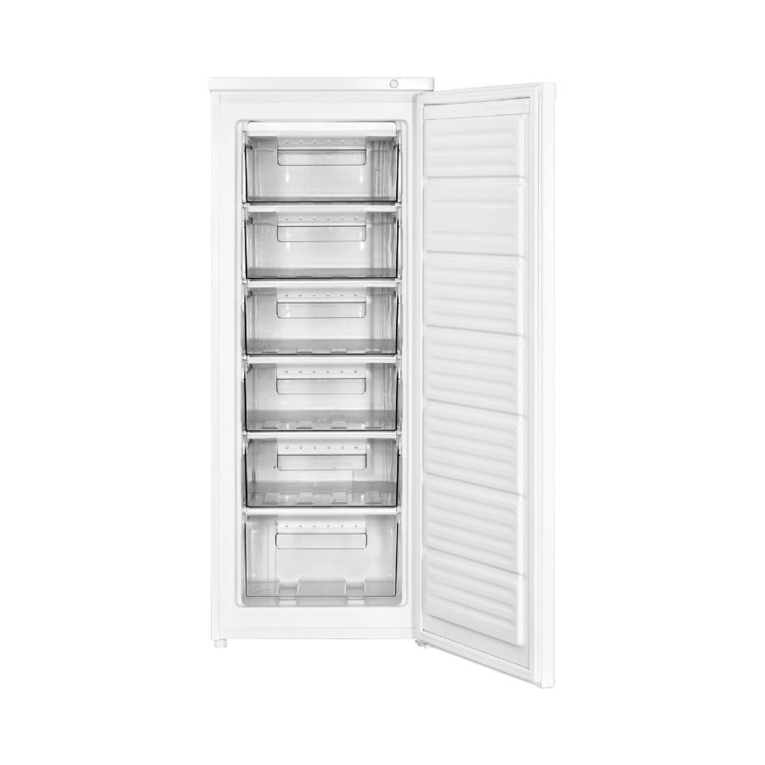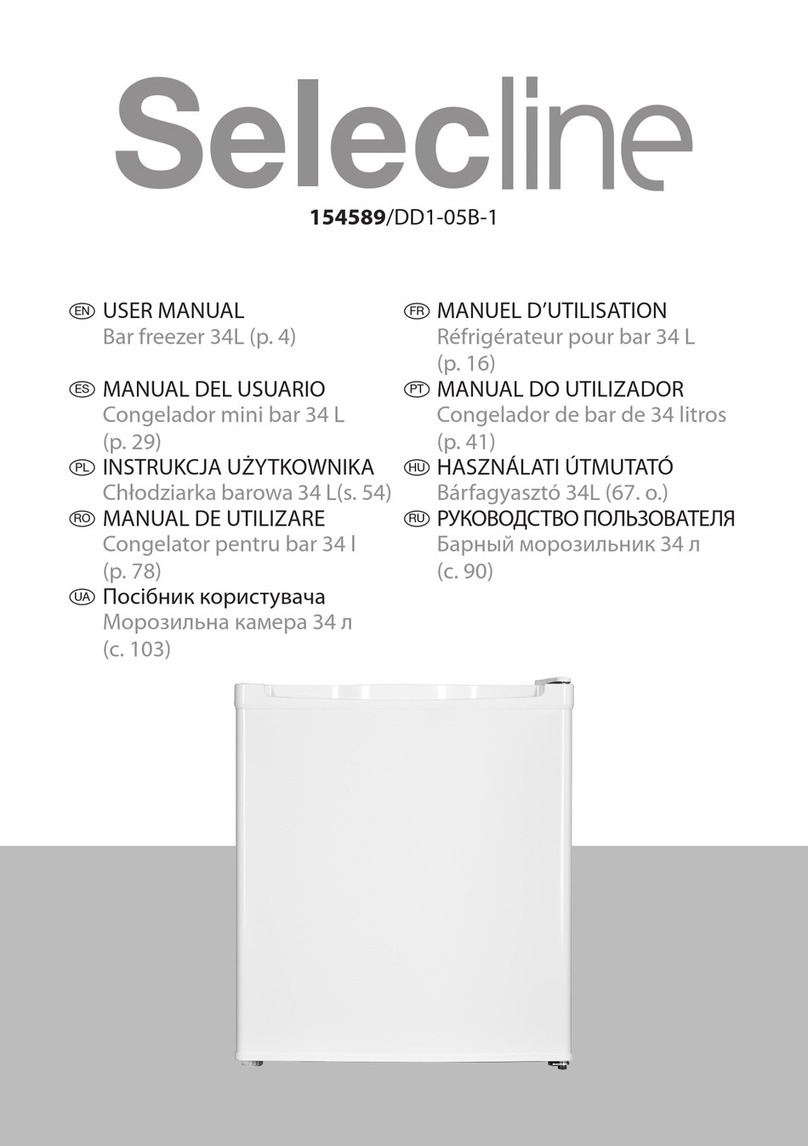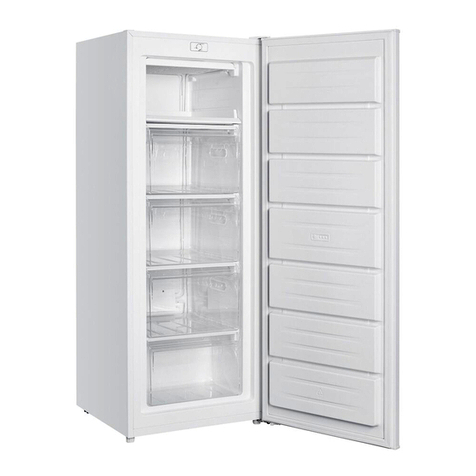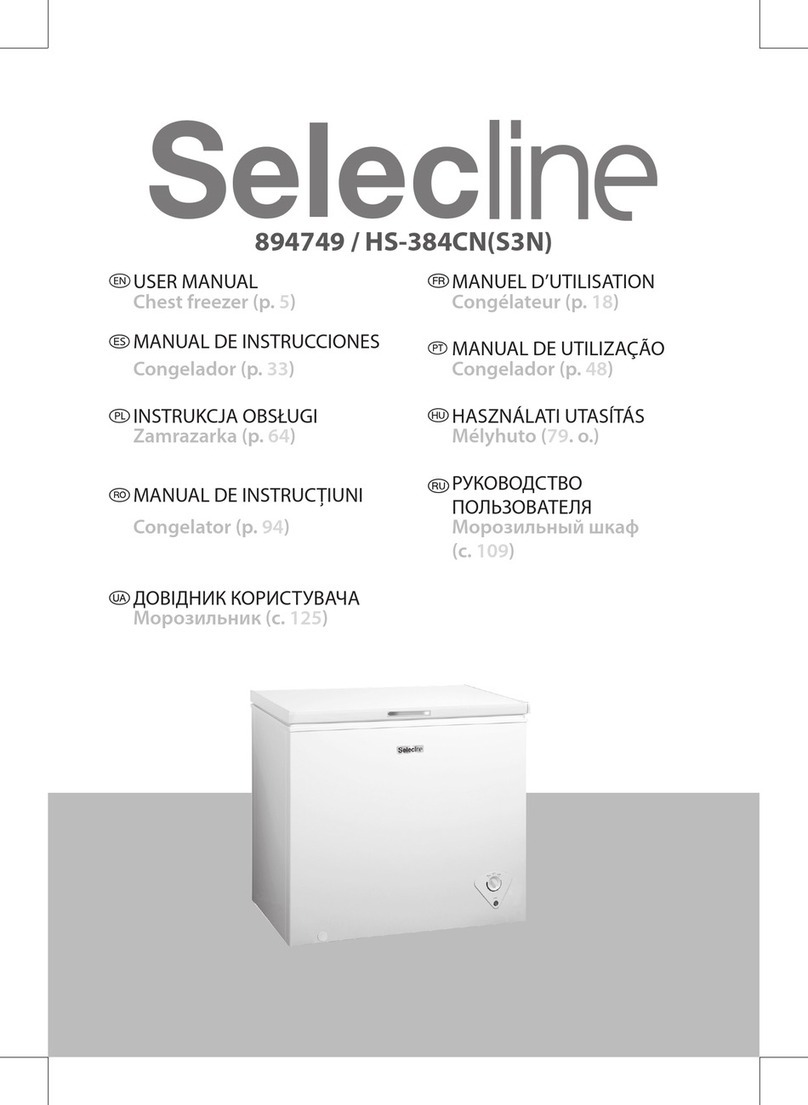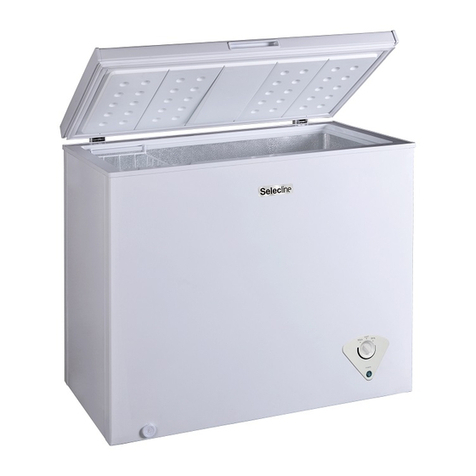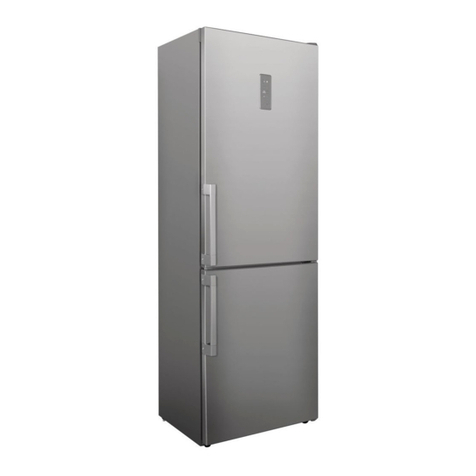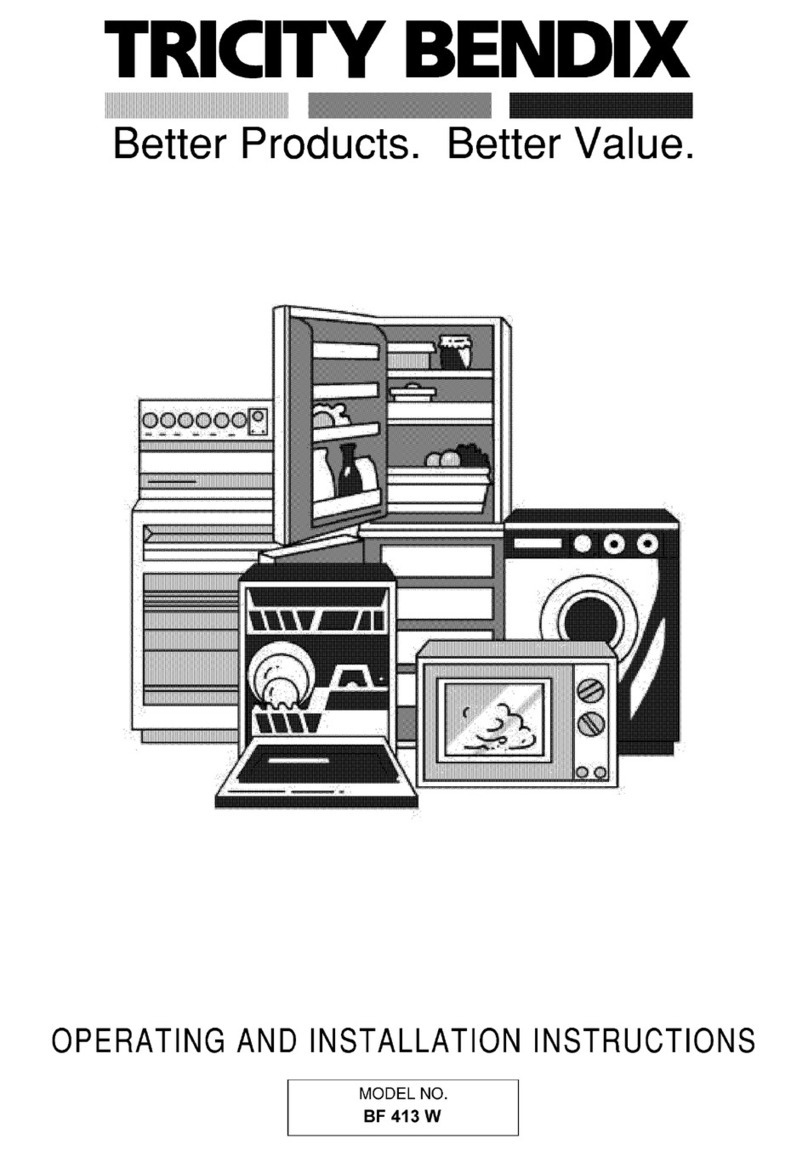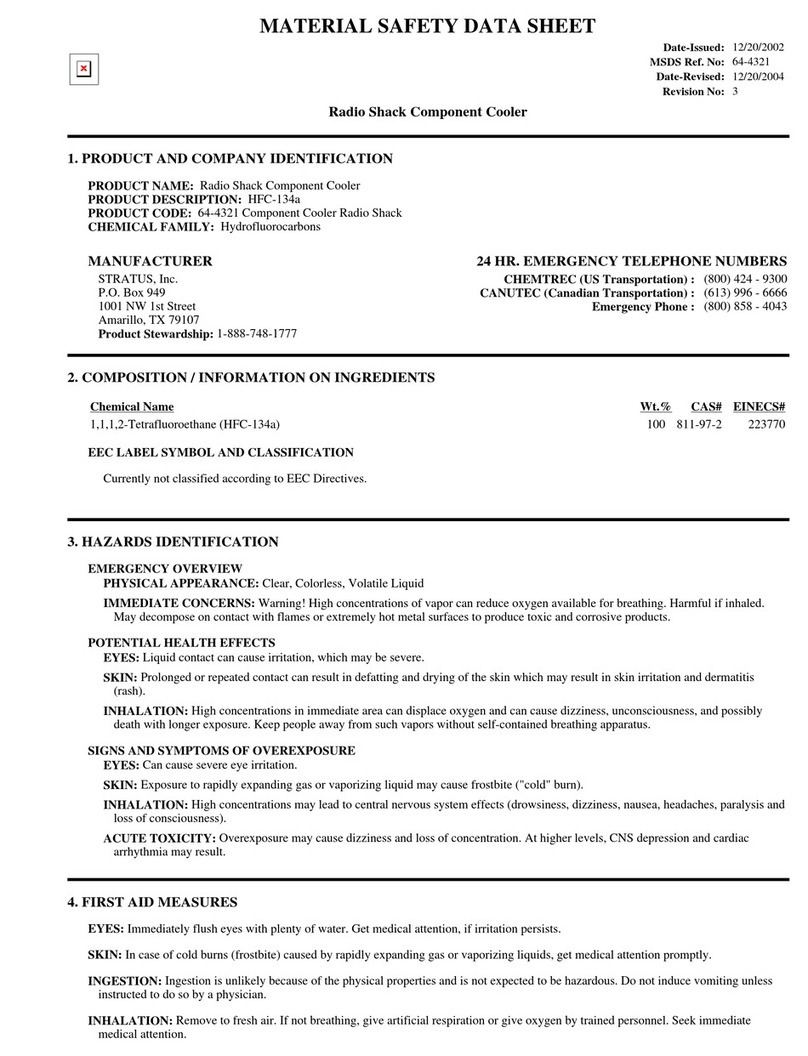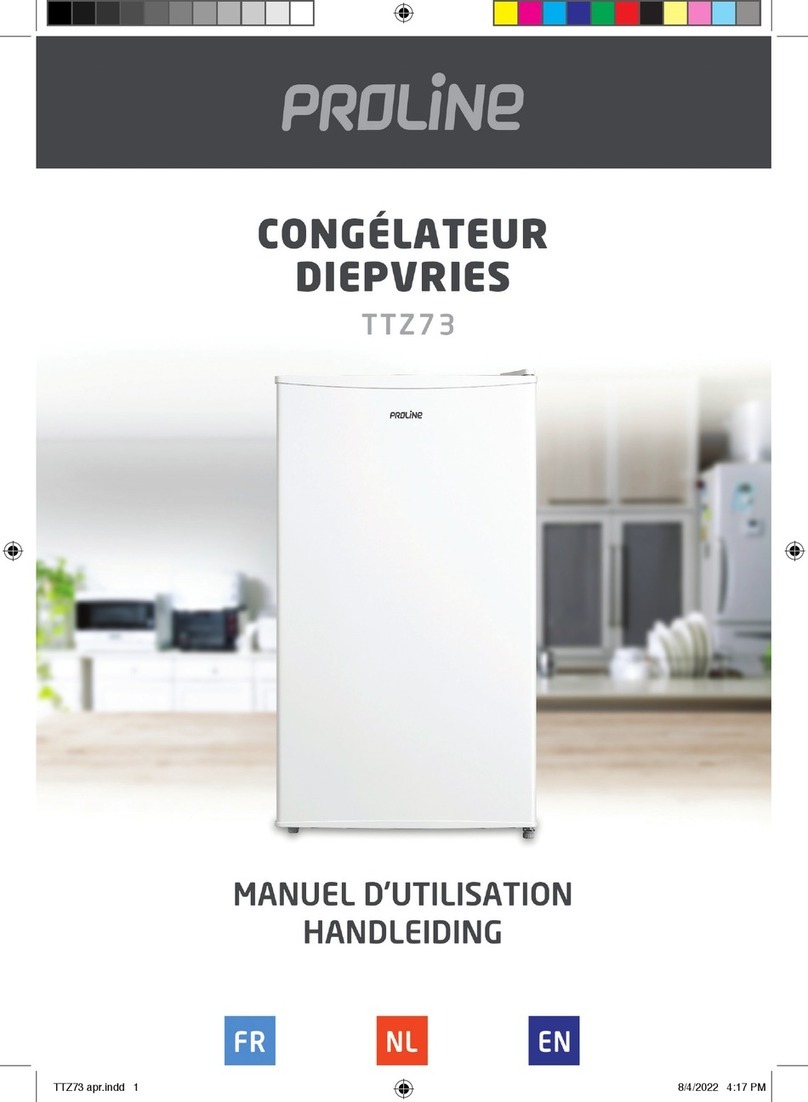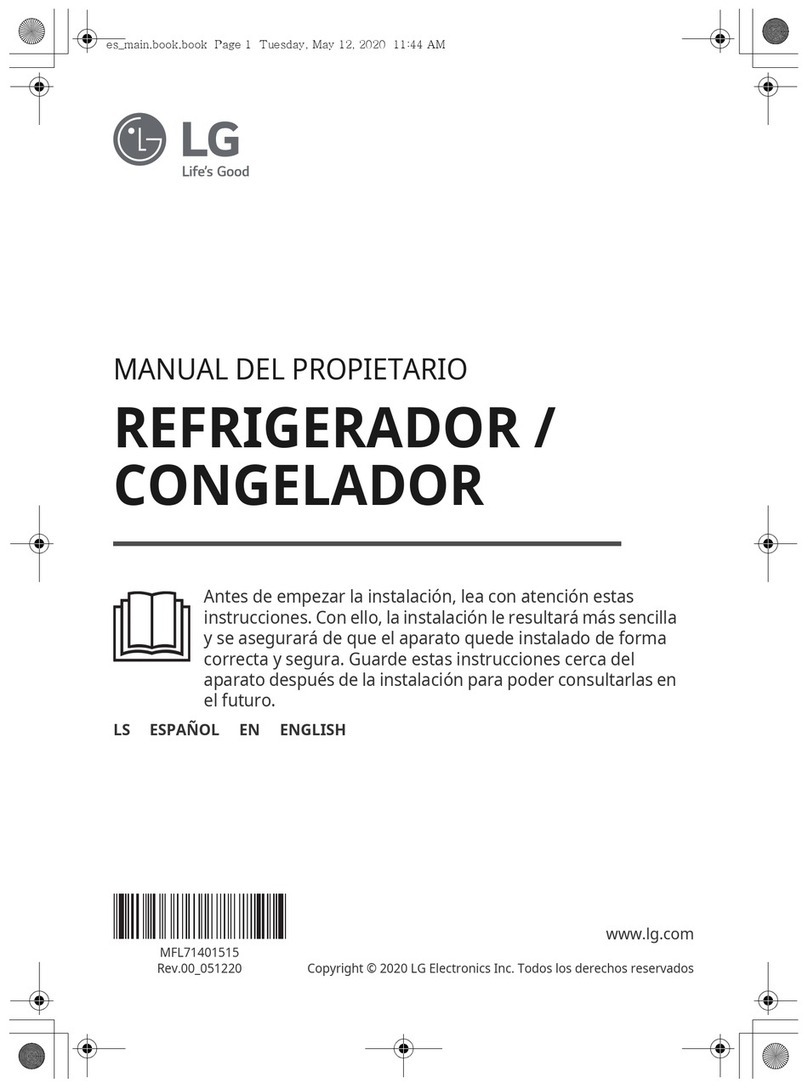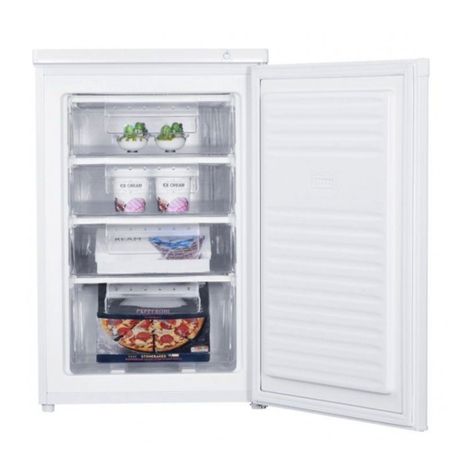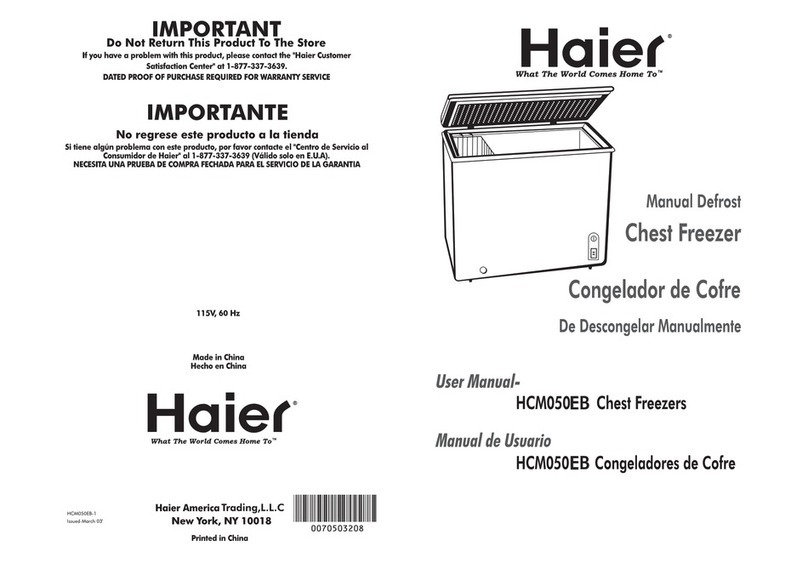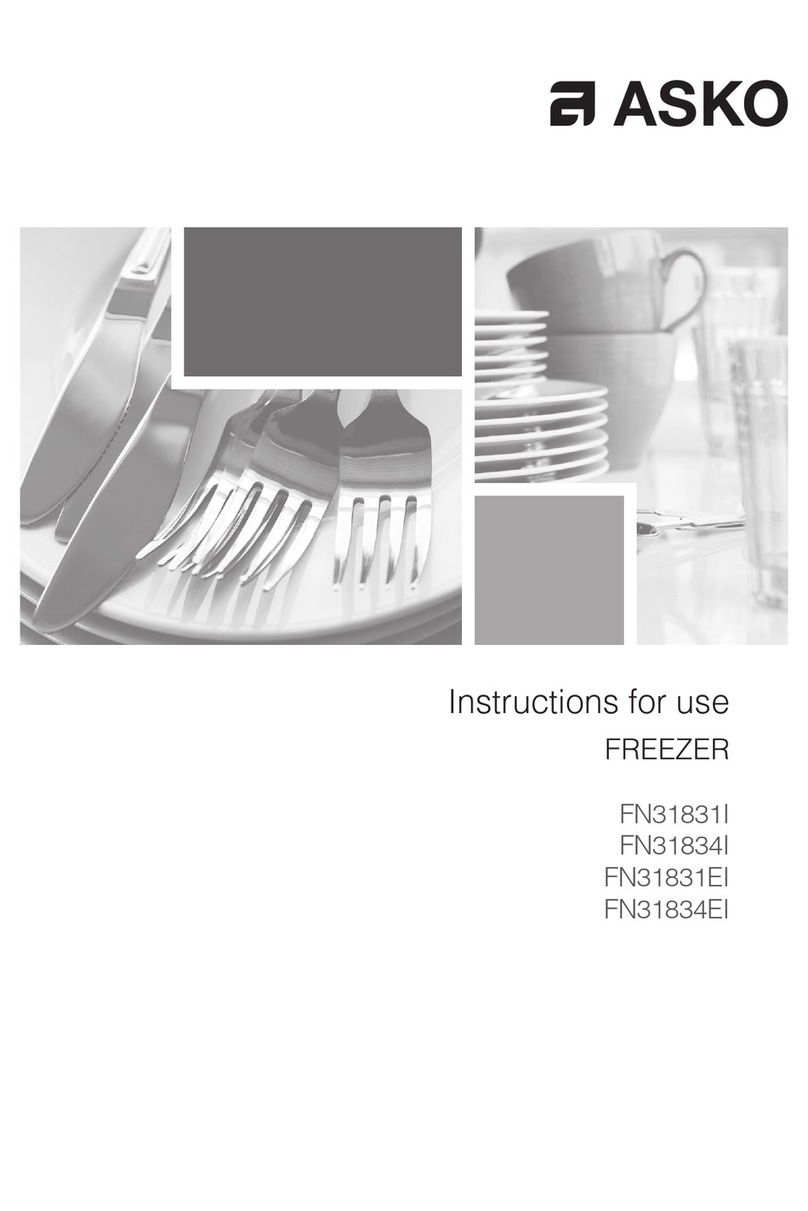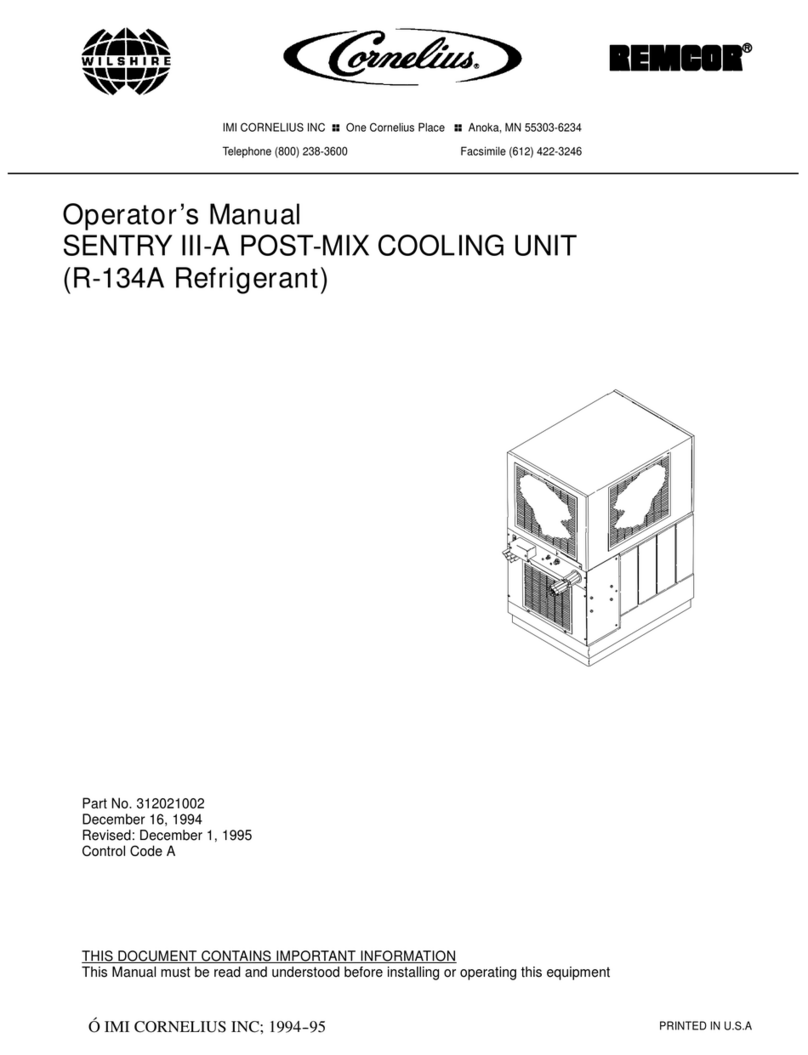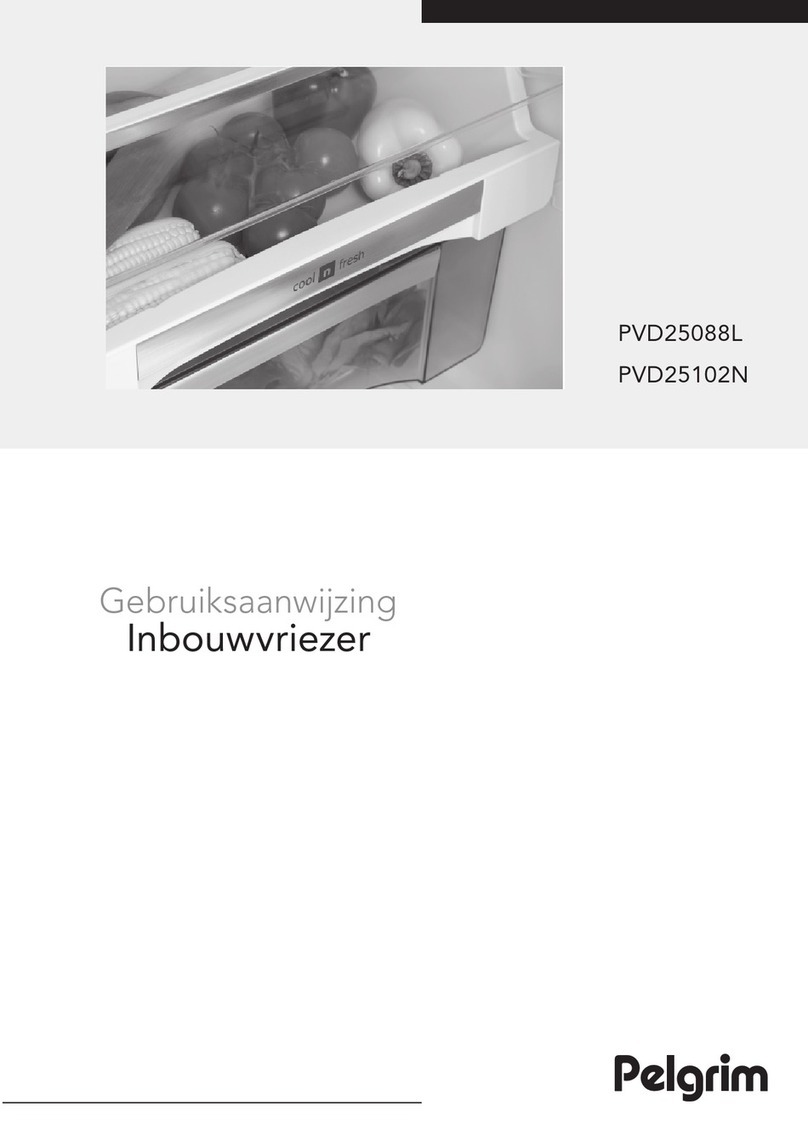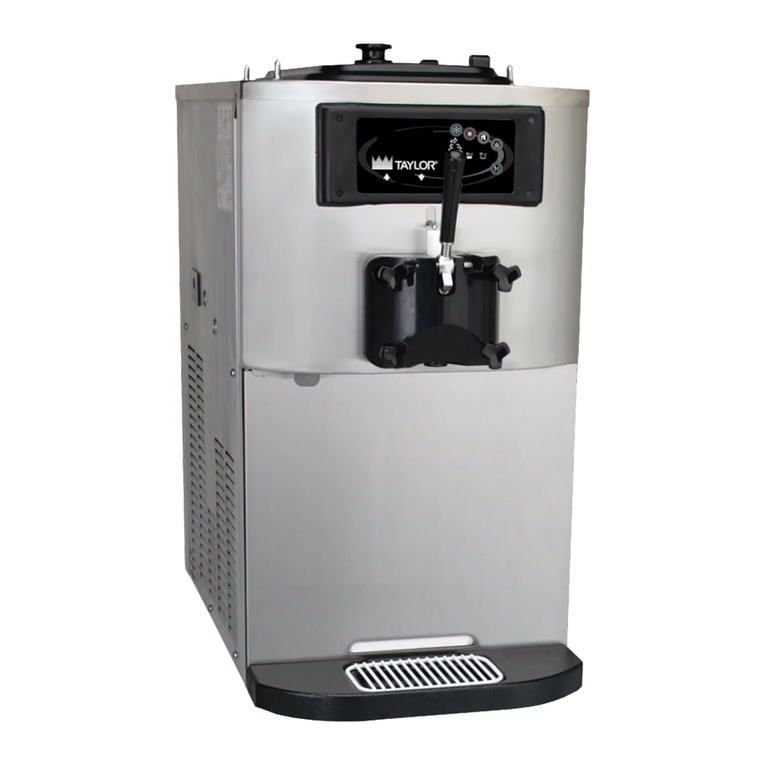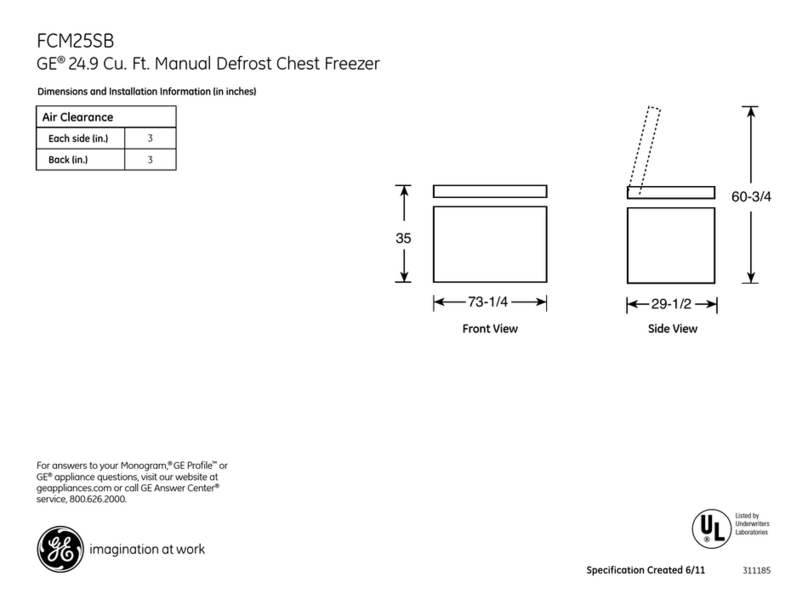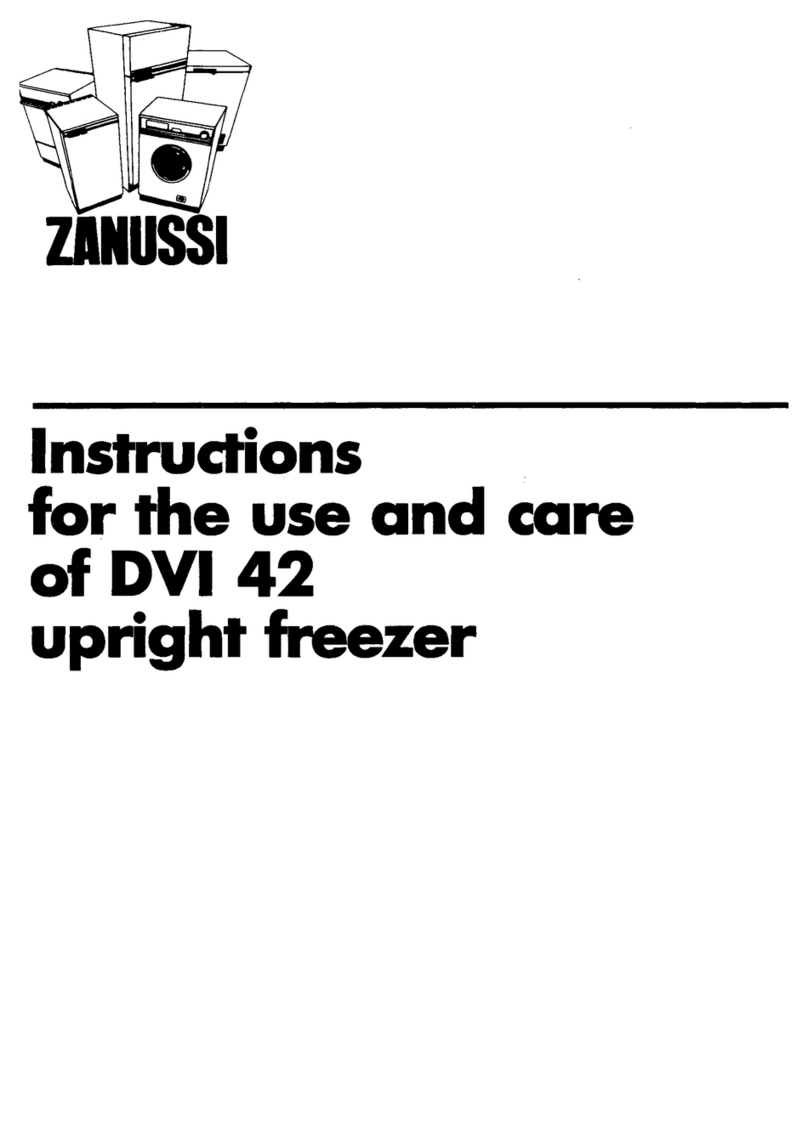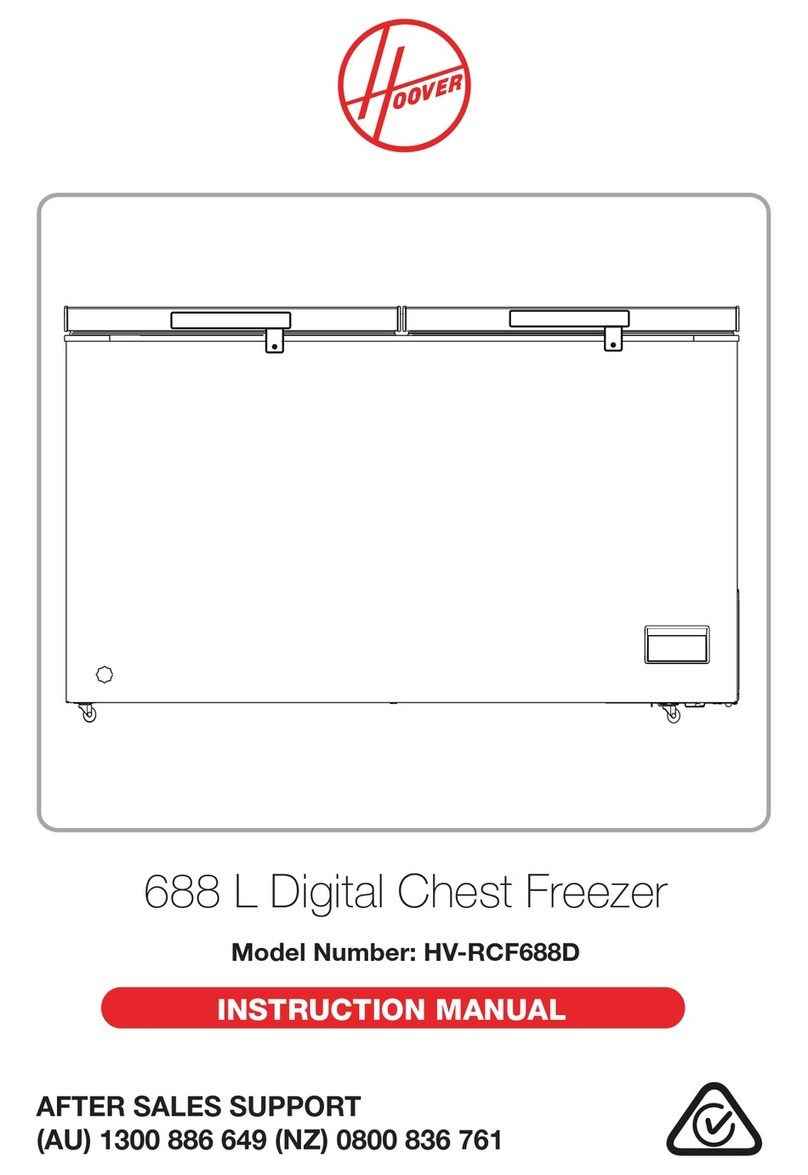Selecline HS-91FN User manual

600081564 / HS-91FN
USER MANUAL MANUEL D’UTILISATION
Freezer (p. 5) Congélateur (p. 16)
MANUAL DE INSTRUCCIONES MANUAL DE UTILIZAÇÃO
Congelador (p. 28) Congelador (p. 40)
INSTRUKCJA OBSŁUGI HASZNÁLATI UTASÍTÁS
Zamrazarka (p. 52) Mélyhuto (64. o.)
MANUAL DE INSTRUCŢIUNI РУКОВОДСТВО
ПОЛЬЗОВАТЕЛЯ
Congelator (p. 76) Морозильный шкаф (c. 88)
ДОВІДНИК КОРИСТУВАЧА
Морозильник (c.102)

*

LH

540 mm
1005 mm
890 mm
135°

5
TABLE OF CONTENTS:
1/ SAFETY INSTRUCTIONS P. 5
2/ TECHNICAL SPECIFICATIONS P. 10
3/ DESCRIPTION P. 10
4/ BEFORE FIRST USE P. 10
5/ USE P. 12
6/ CLEANING AND MAINTENANCE P. 14
7/WARRANTY AND LIMITATION OF LIABILITY P. 14
1/ SAFETY INSTRUCTIONS
Before using this electrical appliance, read the instructions
below carefully and keep them for future reference:
1. Before plugging the appliance into a wall socket, check
that the local electric current corresponds to the current
specified on the rating plate affixed to the appliance. Always
plug your appliance into an earthed wall socket.
2. If the supply cord is damaged, it must be replaced by
the manufacturer, its service agent or similarly qualified
persons in order to avoid a hazard.
3. A special plug is installed with your appliance’s power
cable. This plug must be plugged into an earthed wall
socket, with a power of at least 16 amps. If you do not have
such a wall socket, please have it installed by a qualified
electrician.
4. Donot usewith aprogrammer,timer,remotecommand
system or any other device that powers on the appliance
automatically.
5. Do not use an extension or multi-socket adapter.

6
6. Risk of electric shock! Do not try to repair the appliance
yourself. In the event of a malfunction, repairs must be
carried out by qualified personnel.
7. Do not touch the plug with wet hands.
8. This appliance can be used by children aged at least
8years old and by persons with reduced physical, sensory
or mental capacities or without experience or knowledge,
it they are properly monitored or if instructions for safely
using the appliance have been given to them and if the
risks involved are understood.
9. Children must not play with the appliance.
10. Keep the openings of the room in which the appliance
is located open.
11. This appliance is intended to be used in household and
similar applications such as:
– staff kitchen areas in shops, offices and other working
environments;
– farm houses and by clients in hotels, motels and other
residential type environments;
– bed and breakfast type environments;
– catering and similar non-retail applications.
12. WARNING: Do not use mechanical devices or other
means to accelerate the defrosting process, other than
those recommended by the manufacturer.
13. WARNING: Do not use electrical appliances inside the
food storage compartments of the appliance, unless they
are of the type recommended by the manufacturer.
14. Do not damage the refrigerant circuit.

7
15. WARNING: Keep ventilation openings, in the appliance
enclosure or in the built-in structure, clear of obstruction.
16. The refrigerant gas R600a contained in the refrigerator
is an environmentally safe, combustible natural gas. As
such, it is important to transport and install your refrigerator
carefully so as not to damage the refrigerant pipes. In the
event of a bump or gas leak, avoid all contact with a flame
or fireplace nearby and ventilate the room.
17. It is recommended not to use sharp metallic objects or
other artificial objects to speed up the defrosting.
18. Do not store explosive substances such as aerosol cans
with a flammable propellant in this appliance.
19. The appliance cannot be built into a piece of furniture
or in a practical accommodation, in a wall or in similar
locations.
20. To prevent the appliance from deteriorating in any way,
transport it in its usage position equipped with its transport
brackets.
21. Unplug the power cable from the power socket before
maintenance or cleaning.
22. To avoid any risks related to the instability of the
appliance, it must be secured according to the instructions.
23. Tips for cleaning and defrosting the appliance are
provided in the“ Cleaning and Maintenance ”chapter.
24. Defective electrical appliances must be recycled,
not disposed of with household waste. Please
actively help us in our efforts to preserve resources and
protect the environment by disposing of this appliance at
dedicated collection centres and rubbish dumps.

8
25. This appliance is only appropriate for storing food. The
refrigerator must not be used for other purposes, such as
storing blood or medicine.
26. Risk of suffocation! Keep all packaging materials out of
the reach of children and babies!
27. Recycle the packaging materials in accordance with
regulations.Asklocalauthoritieswherededicatedcollection
centres and rubbish dumps are located.
28. Children aged 3 to 8 are permitted to use refrigeration
appliances to put away and take out food.
29. WARNING: Risk of fire/flammable materials
30. WARNING: When positioning the appliance,
ensure the supply cord is not trapped or damaged.
WARNING: Do not locate multiple portable socket-
outlets or portable power supplies at the rear of the
appliance.
31. To avoid contamination of food, follow the instructions
below:
– Opening the door for long periods can cause a
significant increase in the temperature of the appliance’s
compartments.
– Regularly clean surfaces that may come into contact with
food and accessible drainage systems.
– Clean water tanks if they have not been used for 48 hours;
flush the water system connected to the water supply if
water has not been drawn for 5 days.*
– Store raw meat and fish in suitable containers in the
refrigerator to ensure that it does not come into contact
with or drip onto other food.

9
– Two-star frozen-food compartments are suitable for
storing pre-frozen food, storing or making ice-cream and
making ice cubes.*
– One , two , three-star and four-star
compartments are not suitable for freezing fresh food.*
– If the refrigerating appliance is left empty for long periods,
switch off, defrost, clean, dry, and leave the door open to
prevent mould developing within the appliance.
– For appliances without a 4-star compartment: this
refrigerating appliance is not suitable for freezing
foodstuffs.*
*Note: Please confirm whether this is applicable according
to your product compartment type.
32. Dispose of the appliance according to local regulations
as it contains a flammable refrigerant gas.
33. Thisappliancecanbeusedbychildrenagedfrom8years
and above and persons with reduced physical, sensory or
mental capabilities or lack of experience and knowledge if
they have been given supervision or instruction concerning
use of the appliance in a safe way and understand the
hazards involved. Cleaning and user maintenance shall
not be made by children without supervision. Children
aged from 3 to 8 years are allowed to load and unload
refrigerating appliances.
34. For freestanding appliances: this refrigerating
appliance is not intended to be used as a built-in appliance.
35. Warning: To prevent hazards caused by an unstable
appliance,theappliancemustbefixedinplaceinaccordance

10
with the instructions.
36. Warning: Only connect the appliance to a potable
water supply. (suitable for ice making machine)
37. To prevent children from becoming entrapped, keep
the appliance out of reach of children and do not allow
them to play in the vicinity of the freezer (or refrigerator).
(Suitable for products with locks).
38. All accessories, such as drawers, shelves, balconies,
should be kept there for lower energy consumption.
2/ TECHNICAL SPECIFICATIONS
Operating voltage: 220 - 240 V~, 50 Hz
Energy consumption E16: 0.331 kwh / 24 h
Energy consumption E32: 0.650 kwh / 24 h
Gross/net volume: 70 L
Protection class: Class I
3/ DESCRIPTION
1. Temperature control
knob (thermostat) 2. Fruit and vegetable
drawer
3. Levelling foot
4. Door
5. Power cord and
plug
* The diagram shows the most energy efficient way to store food in refrigerator.
4/ BEFORE FIRST USE
UNPACKING
1. Unpack all of the parts.
2. Immediately after unpacking, check for completeness and any damage sustained
during shipping. If your package is damaged or incomplete, please contact our
After-Sales department.
CHOOSING AN APPROPRIATE PLACE
Warning! Position your appliance such that it is not
directly exposed to sunlight. This appliance must not be
used outside or be exposed to rain.

11
Warning! It must be separated by a distance of at least
50 cm between sources of heat, such as cookers, ovens,
radiators and other stoves, and at least 5cm from electric
ovens.
Warning! When you move the refrigerator, take care not
to roll it over the power cable or damage it.
1. Place the refrigerator in a well-ventilated area, on a dry, stable and flat surface,
away from direct sunlight and any other heat source.
2. Please leave room at the back of the appliance for air to flow. Do not place it
against a wall to avoid noise caused by vibrations. Make sure that air can
always flow freely around the appliance. Insufficient ventilation could cause the
appliance not to work properly and may increase energy consumption. Leave a
space of at least 10 cm between the refrigerator and the wall, and a space of at
least 30 cm between the top of the refrigerator and the ceiling.
3. If the refrigerator is placed on an unstable surface, you may adjust the balance
of the appliance by using the levelling foot (3). That will ensure proper operation
free from vibrations.
4. Turn the foot clockwise to raise the refrigerator. Turn the foot anti-clockwise to
lower the refrigerator ( fig. 1).
5. Be sure to leave enough space to be able to access and open the door easily
(fig. 12). If necessary, you can change the direction in which the door opens as
described below.
REVERSING THE DOOR OPENING DIRECTION
Warning! Unplug the appliance from the power socket
when you reverse the door opening direction.
Warning! During this process, keep all of the parts
together and out of the reach of children.
1. Fix the door in place with solid adhesive tape ( fig. 3).
2. Remove the top cover using a screwdriver ( fig. 4).
3. Carefully remove the top cover ( fig. 5).
4. Loosen the bolts on the top hinge using a socket wrench ( fig. 6).
5. Remove the levelling foot (7) and the bottom hinge using a socket wrench
( fig. 7).
6. Install the top and bottom hinges as well as the levelling foot on the opposite
side of the door using a socket wrench ( fig. 8,9, 10).
7. Replace the top cover and secure it with screws removed previously ( fig. 11).
8. Remove the adhesive tape.

12
5/ USE
OPERATION
1. After being transported, unpacked and installed, before first use, you must allow
your appliance to stand for 30 minutes in a vertical position.
2. Clean the appliance and its components ( 6/ CLEANING AND MAINTENANCE,
p. 13).
3. Before connecting the appliance to the power supply, make sure
the thermostat control button (1) is set to position (level 0)
(ADJUSTING THE TEMPERATURE
4. Connect the plug (5) to the mains supply.
5. Set the temperature to a high level using the temperature adjust button (1)
( fig. 13).
6. Before storing any food, whether fresh or frozen, the refrigerator must have been
working for 2 to 3hours, or for more than 4 hours in summer, when the room
temperature is high.
ADJUSTING THE TEMPERATURE
1. Turn the thermostat button (1) clockwise to the desired position. Position (4) is
the coldest temperature, position (1) is the least cold, and position turns off the
appliance.To completely stop the refrigerator, unplug it from the mains supply (5).
2. The temperature inside the appliance depends on several factors, such as the
room temperature, the quantity of foodstuffs stored, how often the door is
opened, etc. Adjust the temperature button accordingly.
Note:
Recommended setting: Mid-range
STORING FOOD
1. Allow cooked food to cool at room temperature before putting them in the
refrigerator.
2. We recommend that you vacuum-pack food before placing it in the refrigerator.
3. Fruit and vegetables can be stored more easily in the fruit and vegetable drawer (2).
Notes:
■Store excessive amounts of food while the refrigerator is running can damage its
ability to freeze.
■Food stored must not block outgoing air, otherwise the appliance’s ability to
freeze will also be negatively impacted.
Impact on food storage
■Under Recommended setting, the best storage time of fridge is no more than 3
days.
■Under Recommended setting, the best storage time of freezer is no more than 1
month.
■The best storage time may reduce under other settings.

13
Food storage advice
Refrigerator
compartment Food type
Door shelves Food with natural preservatives such as jams, juice, drinks, condiments.
Do not store perishable food.
Vegetable drawer
Fruits, herbs and vegetables must be placed separately in this drawer.
Bananas, potatoes, onions and garlic should not be stored in the
refrigerator.
Bottom shelf
Meat drawer Raw meat, poultry, fish (for short-term storage)
Middle shelf Dairy products, eggs
Top shelf Food that does not require cooking such as ready meals, cold meats,
leftovers.
Freezer drawer(s)/
shelf(ves)
Food to be stored for a long time
Bottom drawer/shelf for raw meat, poultry, fish.
Middle drawer/shelf for frozen vegetables, chips.
Top drawer/shelf for ice cream, frozen fruit, frozen meals.
To avoid contamination of food, please following the following instructions:
■Keep the door open for a long time can lead to a significant drop in
temperature in the appliance’s compartments.
■Regularly clean the surfaces that may come into contact with food and
accessible drainage systems.
■Clean the water tanks if they have not been used for 48 hours; rinse the water
distribution system linked to the water supply if it has not been used for 5 days.
■Store raw meat and fish in the refrigerator in appropriate containers so that
they do not come into contact with other food or leak onto other food.
■The freezer compartments with two stars should be used for storing pre-frozen
food, storing and preparing ice cream and preparing ice cubes.
■Compartments with one, two or three stars should not be used for freezing
fresh food.
■If the refrigerator is empty for a long time, turn it off, defrost it, clean it, wipe
it down and leave the door ajar to prevent mould from building up in the
appliance.
■Do not store hot food and/or liquid directly in the appliance. Always wait until
they cool down before storing them in the appliance.
■Do not place food against the back wall of the appliance.
■Store cleaned fruit and vegetables in the vegetable drawers (3), butter and
cheese in sealed containers and milk bottles in the door compartments (4).
■When you place food in containers or bags, write the date on the packaging to
remind you when the food was stored.
■Avoid opening the doors too often and for too long in order to reduce losses of
cold air and prevent the accumulation of humidity in the compartments.
■Do not freeze defrosted food.
■Follow the manufacturer’s storage recommendations for defrosted food.
■Do not put bottles or sealed containers containing liquid (e.g. beer bottles and
other drinks) in the freezer as they may explode and spoil other food.
■Prepare food in small quantities for facilitate quicker freezing/defrosting. This
will allow you to defrost and cook the appropriate amount of food.

14
6/ CLEANING AND MAINTENANCE
Warning! Before cleaning, make sure the appliance is
switched off. Always remove the plug (5) from the socket
and leave the appliance to cool down before cleaning it.
Warning! Do not use any corrosive detergents, wire
brushes, abrasive cleaners, sharp or metal objects to clean
the appliance.
Rooms Cleaning
Interior
shelves
and walls
■Remove all of the shelves and vegetable drawer
■Wash them with warm water containing a soft
and odourless detergent (e.g. washing-up liquid)
■Rinse using water with bleach solution and dry
thoroughly.
Exterior
■Clean regularly with a soft cloth and soft
detergent.
■The dust behind the refrigerator and on the floor
must be cleaned in a timely manner to improve
the cooling effect and save energy.
MOVING THE REFRIGERATOR
Warning! Do not place the appliance upside down or on
its side. While moving, it must not be tiled more than 45°.
1. If the appliance has to be moved, first remove all the food and
items stored inside, and secure all the accessories inside the
refrigerator with adhesive tape.
2. Secure the levelling foot.
3. Close the door and secure it with adhesive tape.
4. Secure the power cable (5) on the outside of the appliance
with scotch tape to avoid damaging it during transport.
7/WARRANTY AND LIMITATION OF LIABILITY
This product is guaranteed for a period of 12 to 24 months (as defined by local
legislation, with the period as per the till receipt) from the date of purchase, against
any fault resulting from a defect in materials or manufacturing.
This warranty does not cover damages caused by improper use or normal wear and
tear of the product.

15
Specifically, the warranty does not cover:
■Damage or problems caused by improper use, an accident, an alteration or power
supply of unsuitable current or voltage.
■Modified products, or those whose warranty seal or serial number is damaged,
altered, removed or oxidised.
■Replaceable batteries and accessories are guaranteed for a 6-month period.
■Battery failure, caused by excessively lengthy charging or by the failure to observe
the safety precautions explained in the manual.
■Visual damage, including scratches, dents or any other elements.
■Damage caused by any intervention conducted by a non-accredited person.
■Defects caused by normal wear and tear or due to normal ageing of the product.
■Software updates, due to a change in network settings.
■Product failures due to the use of third-party software to modify, change or adapt
the existing software.
■Product failures due to the use of accessories that have not been approved by the
manufacturer.
■Oxidised products.
The manufacturer cannot, under any circumstances, be held responsible for the loss
of data stored on the disc. Likewise, the manufacturer is not obliged to verify that
SIM/SD cards are properly removed from returned products.
Repaired or replaced products may include new and/or reconditioned components
and equipment.
METHODS FOR INVOKING THE WARRANTY
To obtain a warranty service, please bring your product to your point of sale’s
welcome desk along with your proof of purchase (till receipt, bill, etc.), the product
and the accessories provided, along with its original packaging.
It is important to have the following information: date of purchase, model, and serial
or IMEI number (this information generally appears on the product, packaging or
your proof of purchase).
Failing that, you must bring back the product along with the accessories required for
it to operate properly (power supply, adapter, etc.).
In the event that your claim is covered by the warranty, the customer service
department may, within the limits of local legislation, either:
■Repair or replace the defective components.
■Exchange the returned product for a product that has at least the same functions
and that is equivalent in terms of performance.
■Reimburse the product at the price of purchase of the product as indicated on
the proof of purchase.
If one of these 3 solutions is used, this does not entitle the purchaser to an extension
or renewal of the warranty period.`

16
TABLE DES MATIERES
1/ CONSIGNES DE SECURITE P. 16
2/ CARACTERISTIQUES TECHNIQUES P. 22
3/ DESCRIPTION P. 22
4/ AVANT LA PREMIERE MISE EN SERVICE P. 22
5/ UTILISATION P. 23
6/ NETTOYAGE ET ENTRETIEN P. 25
7/ GARANTIE ET LIMITES DE RESPONSABILITE P. 26
1/ CONSIGNES DE SECURITE
Avant d’utiliser cet appareil électrique, lisez attentivement
les instructions ci-dessous et conservez le mode d’emploi
pour un usage ultérieur :
1. Avant de brancher l’appareil à une prise de courant,
assurez-vous que le courant électrique local correspond
bien à celui indiqué sur la plaque signalétique apposée sur
l’appareil. Branchez toujours votre appareil sur une prise
reliée à la terre.
2. Si le câble d’alimentation de cet appareil est
endommagé, il doit être remplacé par le fabricant, son
revendeur agréé ou une personne de qualification similaire
pour éviter tout danger.
3. Une prise spéciale est installée au câble d’alimentation
de votre appareil. Cette prise doit être obligatoirement
branchée sur une prise murale avec terre, d’une valeur d’au
moins 16 ampères. Si vous ne disposez pas d’une telle prise
murale, veuillez la faire installer par un électricien qualifié.
4. Nepasmettreenmarcheaumoyend’unprogrammateur,

17
d’une minuterie, ou d’un système de commande à distance
séparé ou tout autre dispositif qui met l’appareil sous
tension automatiquement.
5. N’utilisez pas de rallonge ou de multiprise.
6. Risque de choc électrique ! N’essayez pas de réparer
l’appareil vous-même. En cas de dysfonctionnement,
les réparations doivent être effectuées par du personnel
qualifié.
7. Ne touchez pas la fiche électrique avec les mains
humides.
8. Cet appareil peut être utilisé par des enfants âgés
d’au moins 8ans et par des personnes ayant des capacités
physiques, sensorielles ou mentales réduites ou dénuées
d’expérience ou de connaissance, s’ils (si elles) sont
correctement surveillé(e)s ou si des instructions relatives
à l’utilisation de l’appareil en toute sécurité leur ont été
données et si les risques encourus ont été appréhendés.
9. Les enfants ne doivent pas jouer avec l’appareil.
10. Maintenir les ouvertures de la pièce dans laquelle se
trouve l’appareil ouvertes.
11. Cet appareil est destiné exclusivement à des usages
domestiques et analogues tels que dans :
– l’espace cuisine du personnel de magasins, bureaux et
autres environnements professionnels ;
– les hôtels, motels et autres environnements à caractère
résidentiel ;
– les environnements de type chambres d’hôte ;
– les restaurants et autres secteurs similaires hors
distribution.
12. N’utilisez pas d’appareils mécaniques ou d’autres

18
moyens en dehors de ceux recommandés par le fabricant
pour accélérer le processus de dégivrage.
13. N’utilisez pas des appareils électriques à l’intérieur du
réfrigérateur.
14. N’endommagez pas le circuit réfrigérant.
15. Maintenir dégagées les ouvertures de ventilation dans
l’enceinte de l’appareil ou dans la structure d’encastrement.
16. Le gaz réfrigérant R600a qui est contenu dans
le réfrigérateur est un gaz naturel et non nuisible à
l’environnement, mais combustible. Il est donc important
de transporter et installer votre réfrigérateur avec soin afin
de ne pas endommager les conduits réfrigérants. Dans le
cas d’un choc ou fuite de gaz, éviter tout contact avec une
flamme ou un foyer à proximité et ventiler le local.
17. Il est recommandé de ne pas utiliser des objets
métalliques pointus ou autres objets artificiels pour
accélérer la décongélation.
18. Ne conservez pas les substances explosives telles que
les générateurs d’aérosol avec propulseur inflammable
dans cet appareil.
19. L’appareil ne peut pas être encastré dans un meuble
ou dans un logement pratique dans un mur ou dans des
emplacements analogues.
20. Pour éviter tout risque de détérioration de l’appareil,
transportez- le dans sa position d’utilisation muni de ses
cales de transport.
21. Débranchez la fiche d’alimentation de la prise de
courant avant de procéder à son entretien ou nettoyage.
22. Pour éviter tout risque dû à l’instabilité de l’appareil,
celui-ci doit être fixé conformément aux instructions.

19
23. Des conseils pour nettoyer et dégivrer l’appareil
peuvent être trouvés au chapitre « Nettoyage et entretien ».
24. Les appareils électriques défectueux
doivent être recyclés et non pas
jetés dans les ordures ménagères. Veuillez activement nous
aider dans notre action pour conserver les ressources et
protéger l’environnement en déposant cet appareil dans
les centres de collecte et déchèteries.
25. Cet appareil est seulement approprié pour le
stockage de nourriture. Le réfrigérateur ne doit pas être
utilisé à d’autres fins, comme le stockage du sang ou des
médicaments.
26. Risque de suffocation ! Conservez tous les matériaux
d’emballage hors de portée des enfants et des bébés !
27. Recyclez les matériaux d’emballage en respectant
la réglementation. Demandez aux autorités locales où se
trouvent les centres de collecte ou déchèteries.
28. Les enfants de 3 à 8 ans sont autorisés à utiliser les
appareils réfrigérants pour placer et extraire des aliments.
29. AVERTISSEMENT : Risque d’incendie/matériaux
inflammables
30. AVERTISSEMENT : Lorsque vous positionnez
l’appareil, assurez-vous que le câble
d’alimentation n’est pas coincé ou endommagé.
AVERTISSEMENT : Ne placez pas une multiprise ou une
rallonge à l’arrière de l’appareil.
31. Pourévitertoutecontaminationdesaliments,respectez
les instructions ci-dessous :
– Ouvrir la porte pendant une durée prolongée peut causer
une augmentation significative de la température des

20
compartiments de l’appareil.
– Nettoyez régulièrement les surfaces pouvant entrer en
contact avec les aliments et les systèmes d’évacuation
accessibles.
– Nettoyez les réservoirs d’eau s’ils n’ont pas été utilisés
pendant 48 heures ; rincez le système d’eau raccordé à
l’alimentation en eau si l’eau n’a pas coulé pendant 5 jours.*
– Conservez la viande et le poisson crus dans des récipients
appropriésauréfrigérateurpourvousassurerqu’ilsn’entrent
pas en contact ou ne coulent pas sur d’autres aliments.
– Les compartiments pour aliments surgelés 2 étoiles
conviennent à la conservation d’aliments pré-congelés, à la
conservation ou à la réalisation de crème glacée et à la
réalisation de glaçons.*
– Les compartiments 1 étoile , 2 étoiles , 3 étoiles
et 4 étoiles ne conviennent pas à la
congélation d’aliments frais.*
– Si l’appareil de réfrigération reste vide pendant une durée
prolongée,éteignez-le,dégivrez-le,nettoyez-le,séchez-leet
laissez la porte ouverte pour empêcher le développement
de moisissure dans l’appareil.
– Pour les appareils sans compartiment 4 étoiles : cet
appareil de réfrigération ne convient pas à la congélation
d’aliments. *
*Remarque : Veuillez vérifier si cela est applicable en
fonction du type de compartiment de votre produit.
32. Eliminez l’appareil conformément à la règlementation
locale étant donné qu’il contient un gaz réfrigérant
inflammable.
This manual suits for next models
1
Table of contents
Languages:
Other Selecline Freezer manuals
